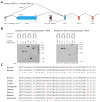Mutational Spectrum of MYO15A and the Molecular Mechanisms of DFNB3 Human Deafness
- PMID: 27375115
- PMCID: PMC5021573
- DOI: 10.1002/humu.23042
Mutational Spectrum of MYO15A and the Molecular Mechanisms of DFNB3 Human Deafness
Abstract
Deafness in humans is a common neurosensory disorder and is genetically heterogeneous. Across diverse ethnic groups, mutations of MYO15A at the DFNB3 locus appear to be the third or fourth most common cause of autosomal-recessive, nonsyndromic deafness. In 49 of the 67 exons of MYO15A, there are currently 192 recessive mutations identified, including 14 novel mutations reported here. These mutations are distributed uniformly across MYO15A with one enigmatic exception; the alternatively spliced giant exon 2, encoding 1,233 residues, has 17 truncating mutations but no convincing deafness-causing missense mutations. MYO15A encodes three distinct isoform classes, one of which is 395 kDa (3,530 residues), the largest member of the myosin superfamily of molecular motors. Studies of Myo15 mouse models that recapitulate DFNB3 revealed two different pathogenic mechanisms of hearing loss. In the inner ear, myosin 15 is necessary both for the development and the long-term maintenance of stereocilia, mechanosensory sound-transducing organelles that extend from the apical surface of hair cells. The goal of this Mutation Update is to provide a comprehensive review of mutations and functions of MYO15A.
Keywords: DFNB3; MYO15A; deafness; giant exon; micro exon; myosin 15; shaker 2.
© 2016 WILEY PERIODICALS, INC.
Conflict of interest statement
statement: All authors declare no conflicts of interest
Figures



References
-
- Anderson DW, Probst FJ, Belyantseva IA, Fridell RA, Beyer L, Martin DM, Wu D, Kachar B, Friedman TB, Raphael Y, Camper SA. The motor and tail regions of myosin xv are critical for normal structure and function of auditory and vestibular hair cells. Hum Mol Genet. 2000;9:1729–1738. - PubMed
Publication types
MeSH terms
Substances
Grants and funding
LinkOut - more resources
Full Text Sources
Other Literature Sources
Medical

